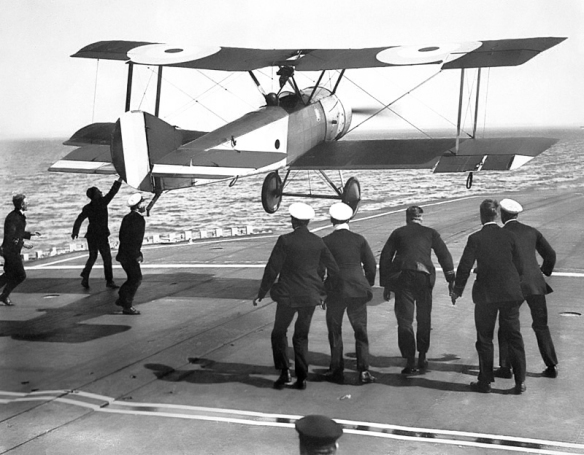
Sqn. Cdr. E. H. Dunning makes the first landing of an aircraft on a moving ship, a Sopwith Pup on HMS Furious, 2 August 1917.
The furnace of war greatly accelerated the development of shipboard aircraft. The performance and capabilities of seaplanes, both floatplanes and flying boats, improved dramatically. Much of this advance came from more powerful engines—in 1914 few seaplanes were powered by engines greater than 200-horsepower but in 1918 shipboard seaplanes commonly used engines of 375-horsepower. This greater engine power translated into stronger airframes, greater load-carrying capacity, and longer range. The Royal Navy’s new Short Type 166 floatplane in 1914, with a 200-horsepower Salmson engine, could carry a 14-inch torpedo but only at the price of operating with a pilot alone and fuel for a round trip of barely 40 miles. At the end of the war the Short Type 320 floatplane, with a 320- horsepower Sunbeam engine, could carry a pilot, observer/gunner, wireless equipment, and an 18-inch torpedo for a distance of just over 200 miles. Similar advances took place with shipboard flying boats, deployed extensively by the French and Russian navies on their seaplane carriers, and also employed on a limited scale by the Austro-Hungarian and Italian fleets aboard ships. There also was a widely produced family of small single-seater floatplanes derived from the winner of the 1914 Schneider Trophy race, the Sopwith Tabloid. Initial production examples, known as Sopwith Schneiders, were powered by 100-horsepower Gnome rotary engines and could carry a single machine gun and a 65-pound bomb at up to 87 miles per hour, with a total endurance of two and one-quarter hours. The final versions, known as Sopwith Babys, were powered by 130-horsepower Clerget rotary engines and could carry two 65-pound bombs at up to 100 miles per hour. They were used on almost all British seaplane carriers for scouting and interception missions, and also used by the French and Italian navies, with most of the latter machines produced under license by Macchi in Italy.
The greatest change, however, in the character of shipboard aircraft during the war, particularly in the Royal Navy, was the dominance of landplane types aboard major warships and fleet carriers by the later years of the conflict. As early as the spring of 1915, when planning began for the conversion of the Vindex, facilities for launching landplane fighter aircraft were incorporated in the design process. The forward flying-off platform on this and later “mixed carriers” was intended for launching both floatplanes (using trolleys) for reconnaissance and landplane fighters to intercept Zeppelins. The first landplanes embarked were Bristol Scouts, with 80- horsepower Gnome rotary engines, capable of 93 miles per hour at sea level and armed with a single machine gun. By 1918 British carriers embarked a specialized variant of the famous Sopwith Camel fitted with a 150-horsepower Bentley rotary engine, giving it a top speed of 117 miles per hour, and carrying two machine guns. It had a slightly smaller wingspan than the normal version and the rear fuselage of this Ship’s Camel was detachable for stowage aboard ship. From mid-1917 most British fleet carriers landed their floatplanes and embarked two-seater Sopwith 1-1/2 Strutter landplanes for reconnaissance missions, and at the war’s end a specialized landplane torpedo bomber, the Sopwith Cuckoo, was entering service in the strike role. This single-seater, with a 200-horsepower Sunbeam engine, could carry an 18-inch torpedo at a maximum speed of 100 miles per hour and had a range of some 240 miles.